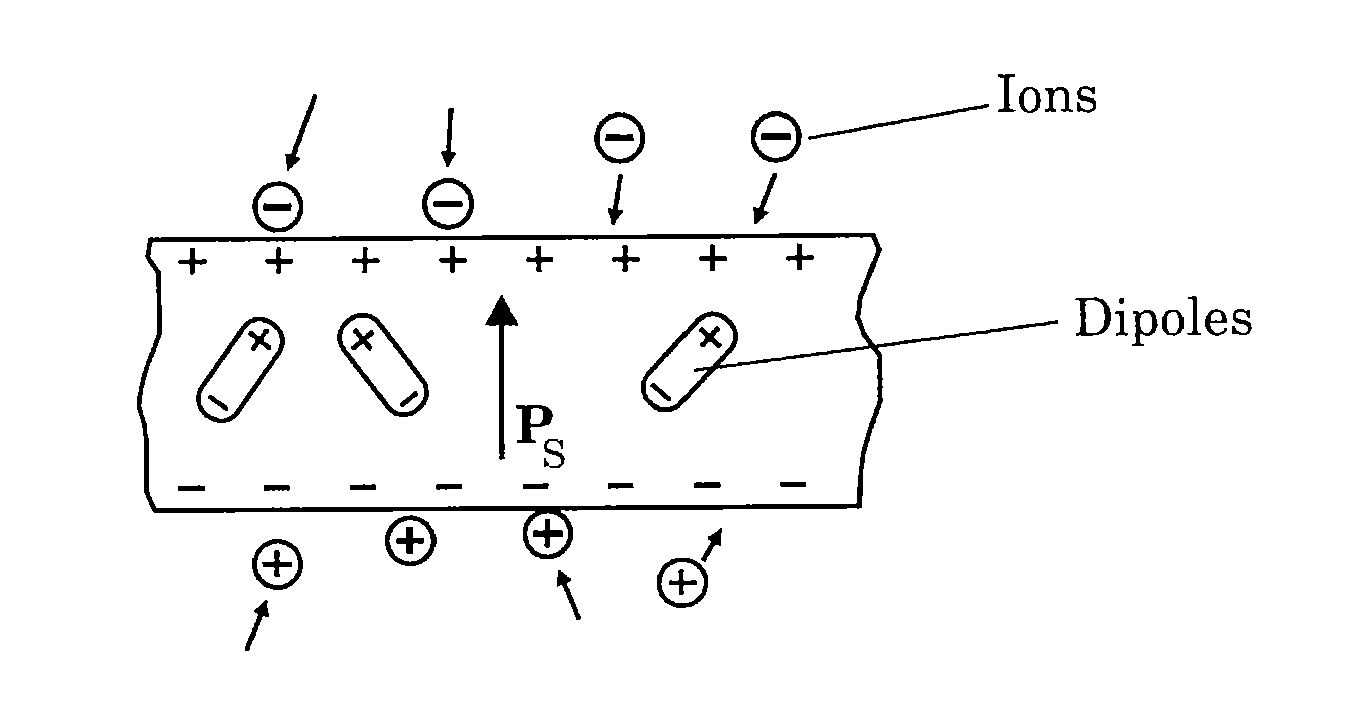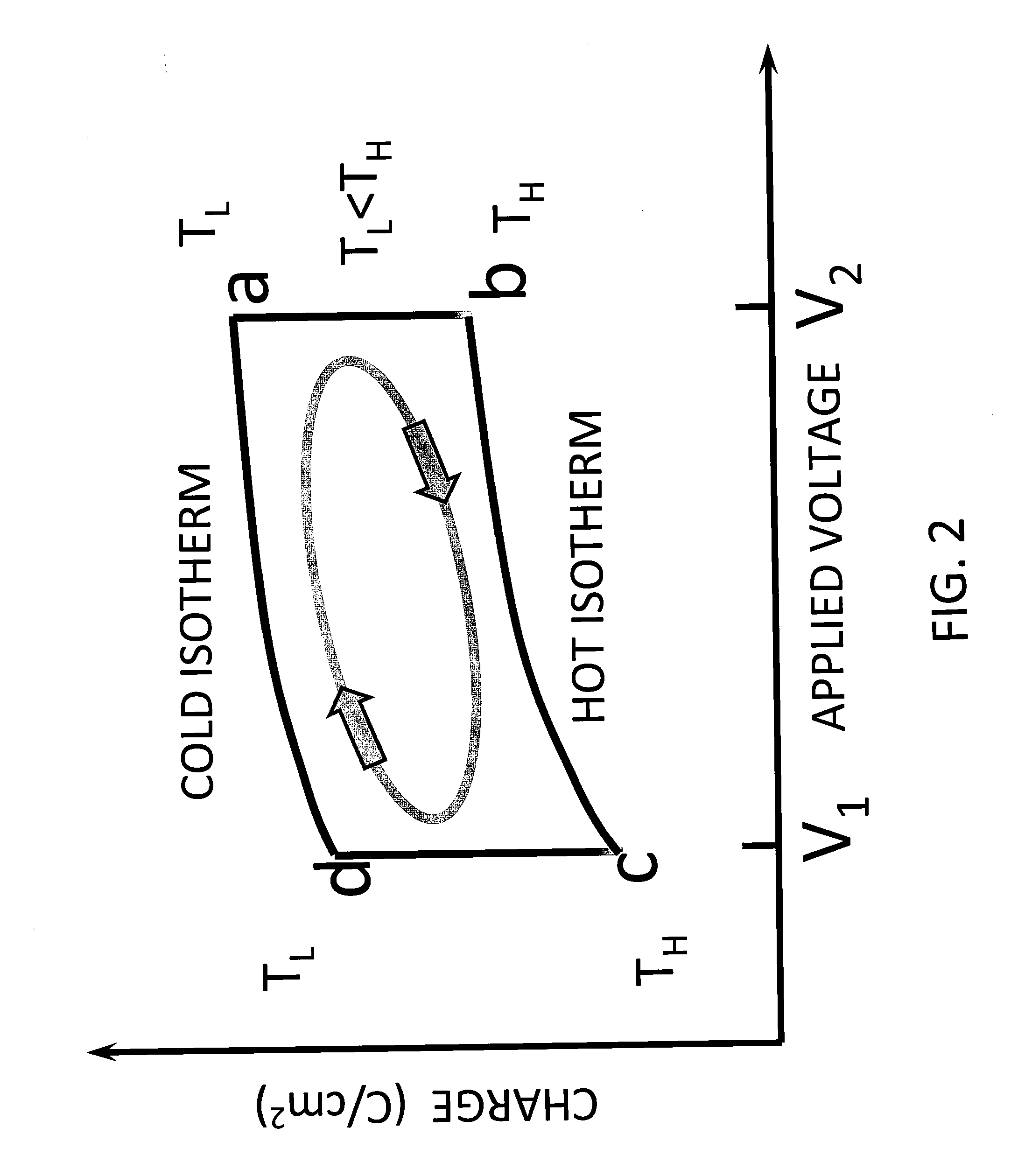MEMS based pyroelectric thermal energy harvester
a pyroelectric and thermal energy harvesting technology, applied in the direction of generators/motors, nuclear engineering, kinetic-electric generators, etc., can solve the problems of low energy conversion efficiency of thermal to electrical energy conversion techniques (thermoelectric, piezoelectric and pyroelectric) and inherent limitations of the conversion technology itself, so as to achieve large reductions and high-quality electrical energy
- Summary
- Abstract
- Description
- Claims
- Application Information
AI Technical Summary
Benefits of technology
Problems solved by technology
Method used
Image
Examples
example 1
[0063]According to preliminary proof of concept testing, a traditional pyroelectric capacitor is fabricated from a polyvinylidene difluoride-trifluoroethylene copolymer (PVDF-TrFE or copolymer) based capacitor. This material includes a relatively high pyroelectric coefficient and dielectric strength and ease of fabrication using current wet chemical and wafer processing equipment and techniques.
[0064]According to this embodiment, the pyroelectric capacitors are preferably fabricated by sputtering Al electrodes onto each side of a 25 μm thick, electrically poled copolymer film. Electrical leads may be attached to the capacitor electrodes using silver based electrically conductive past. The measured capacitances for several of these thin film pyroelectric capacitors ranged from approximately 140 pF up to 1 nF. A 140 pF capacitor generates currents in the 10-15 nA range when exposed to changes in temperature of 15-20° C. Higher conversion efficiencies are achievable through adjustments...
example 2
[0065]According to further proof of concept testing, a pyroelectric capacitor test structure is fabricated from low thermal expansion SiO2, higher thermal expansion Al, and much higher thermal expansion SU-8.
[0066]FIG. 10A-10G show a series of fabrication schematics starting with an Si bare wafer 200 in FIG. 10A. FIG. 10B shows a PE-CVD deposit SiO2 thin film 210, resulting in SiO2 / Si layers. FIG. 10C shows an e-beam deposit of Al thin film 220 resulting in Al / SiO2 / Si layers. FIG. 10D represents a front side lithographic patterning of the structure. FIG. 10E shows an etching of the Al layer 220 and SiO2 layer 210. FIGS. 10F and 10G show backside photolithographic patterning and backside etching of the Si layer 200 to release the biomorphic cantilever structure, respectively.
[0067]The above construction technique is illustrative and is particularly suited to fabrication of test structures and may be adjusted depending on the desired pyroelectric capacitor materials and configuration....
example 3
[0068]According to one preferred embodiment, the fabrication steps leading to the fabrication of a cantilevered pyroelectric capacitive device based on the pyroelectric material aluminum nitride (AIN) is shown schematically in FIG. 11A-H. The AIN material has a lower pyroelectric coefficient than that of the PVDF-TrFE copolymer, but is easier to fabricate into cantilever structures using available processing equipment. A base 100 mm Si wafer 200 is shown in FIG. 11A. The first step in the fabrication of the cantilever structure according to this embodiment uses a 10 μm thick PECVD deposited silicon dioxide layer 260, as shown in FIG. 11B.
[0069]FIG. 11C shows the first photolithography step wherein a 100 nm titanium (Ti) layer 270 is deposited and patterned, and acts as the bottom electrode of the capacitor. Next, as shown in FIG. 11D, the AIN dielectric layer 280 is deposited. FIG. 11E shows the subsequent second photolithography step where the top Ti capacitor electrode layer 290 i...
PUM
 Login to View More
Login to View More Abstract
Description
Claims
Application Information
 Login to View More
Login to View More - R&D
- Intellectual Property
- Life Sciences
- Materials
- Tech Scout
- Unparalleled Data Quality
- Higher Quality Content
- 60% Fewer Hallucinations
Browse by: Latest US Patents, China's latest patents, Technical Efficacy Thesaurus, Application Domain, Technology Topic, Popular Technical Reports.
© 2025 PatSnap. All rights reserved.Legal|Privacy policy|Modern Slavery Act Transparency Statement|Sitemap|About US| Contact US: help@patsnap.com



